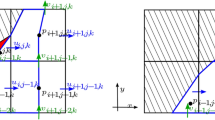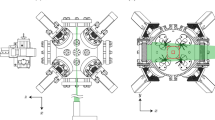Abstract
Flow interaction with a bluff body generates a highly complex flow field and has been the subject of much experimental and theoretical analysis. It has been shown that large eddy simulation (LES) modelling provides a more realistic analysis of the flow for such situations where the large scales of turbulence must be resolved. The inherent small-scale spatial velocity averaging in particle image velocimetry (PIV) is commensurate with the sub-grid scale modelling of LES and, therefore, offers potential as a code refinement technique. To demonstrate this potential, however, PIV must be performed with a temporal resolution of typically kHz and a spatial resolution of sub-mm2 to be relevant for the vast majority of flows of engineering interest. This paper reports the development of a high-speed PIV system capable of operating at 20 kHz with a spatial resolution of 0.9 mm2. This is the combined highest speed, highest resolution PIV data reported to date. The experiment chosen to demonstrate the system is the study of the steady flow interaction with circular and square cross-section obstacles. A Reynolds number of 3,900 is chosen for the cylinder flow to extend the database used by Breuer M. (1998 Int J Heat Fluid 19:512–521) in his extensive LES modelling of this flow. Data presented include a sequence of two-dimensional velocity and vorticity fields, including flow streamlines. Importantly, the random error, inherent in a PIV measurement, is discussed and a formula presented which allows the error to be estimated and regions of the flow identified where LES comparisons would be uncertain.







Similar content being viewed by others
References
Bolinder J (2000) In situ estimation of the random error in DPIV measurements. In: The Proceedings of the 9th International Symposium on Flow Visualisation CDROM Proceedings (ISBN 0 9533991-1-7). Heriot-Watt University, Edinburgh
Breuer M (1998) Numerical and modelling influences on large-eddy simulations for the flow past a circular cylinder. Int J Heat Fluid 19:512–521
Cantwell B, Coles D (1983) An experimental study of entrainment and transport in the turbulent near wake of a circular cylinder. J Fluid Mech 136:321–374
Durst F, Melling A, Whitelaw JH (1982) Principles and practice of laser doppler anemometry. Academic Press, New York
Köhler J, Lawrenz W, Meier F, Meinhardt P, Stolz W, Bloss WH (1993) Flow field diagnostics in industrial devices. Ber Bunsenges Phys Chem 7:1568–1573
Lawson NJ (1995) The application of particle image velocimetry to high speed flows. PhD Thesis, Loughborough University
Lawson NJ, Halliwell NA, Coupland JM (1997) A generalised optimisation method for double pulsed particle image velocimetry. Opt Lasers Eng 27:656–673
Lecordier B, Trinité M (1999) Time-resolved PIV measurements for high-speed flows. Third International Workshop on Particle Image Velocimetry, Santa-Barbara, Calif.
Lorrenco L, Krothapalli A (1994) On the accuracy of velocity and vorticity measurements with PIV. Exp Fluids 18:421–428
Lyn DA, Rodi W (1994) The flapping shear layer formed by flow separation from the forward corner of a square cylinder, J. Fluid Mech 267:353–376
Lyn DA, Einav S, Rodi W, Park J-H (1995) A laser-Doppler velocimetry study of ensemble-averaged characteristics of the turbulent near wake of a square cylinder. J Fluid Mech 304:285–319
Raffel M, Willert C, Kompenhans J (1998) Particle image velocimetry: a practical guide. Springer, Berlin Heidelberg New York
Reeves M, Garner CP, Dent JC, Halliwell NA (1996) Particle image velocimetry analysis of IC engine in-cylinder flows. Opt Lasers Eng 25:415–432
Rodi W (1998) Large-eddy simulations of the flow past bluff bodies: state-of-the art. JSME Ser B 41:361–374
Rodi W, Ferziger JH, Breuer M, Pourquie M (1997) Status of large eddy simulation: results of a workshop. J Fluids Eng 119:248–263
Willert CE, Gharib M (1991) Digital particle image velocimetry. Exp Fluids 10:181–193
Author information
Authors and Affiliations
Corresponding author
Rights and permissions
About this article
Cite this article
Williams, T.C., Hargrave, G.K. & Halliwell, N.A. The development of high-speed particle image velocimetry (20 kHz) for large eddy simulation code refinement in bluff body flows. Exp Fluids 35, 85–91 (2003). https://doi.org/10.1007/s00348-003-0638-5
Received:
Accepted:
Published:
Issue Date:
DOI: https://doi.org/10.1007/s00348-003-0638-5




